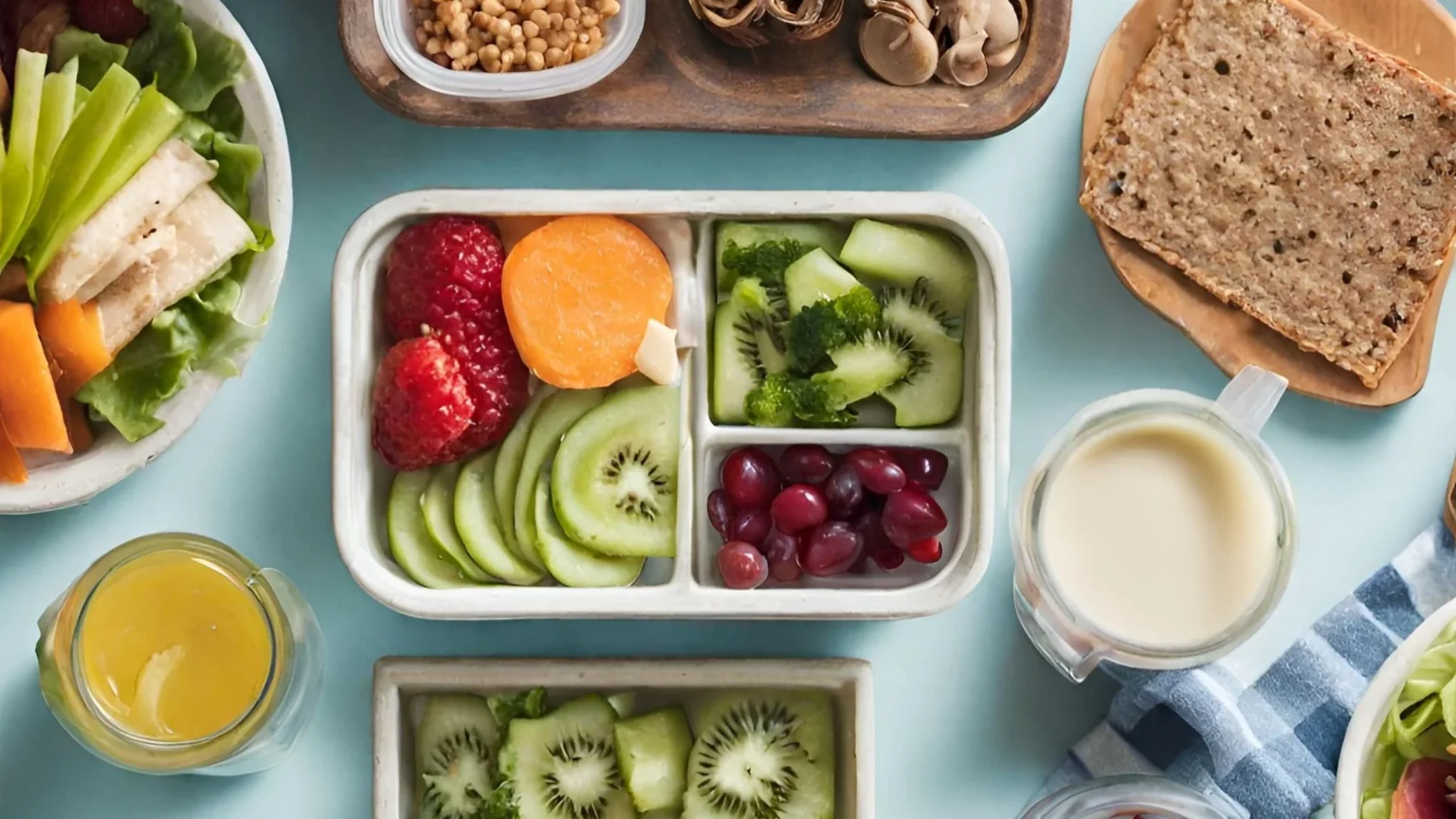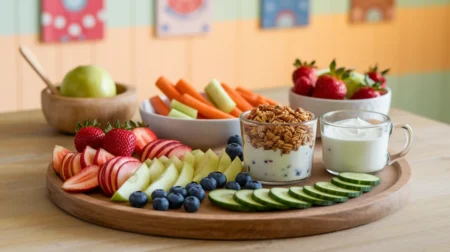Welcome to college life! As a college student living in a dorm, finding ways to eat healthy with limited options can be a challenge. But fear not, we are here to help. In this article, we will provide you with practical strategies and tips on how to eat healthy in a dorm, whether you have a meal plan, use a microwave for cooking, or rely on the dorm cafeteria. You can nourish your body and make smart food choices, even in a small dorm room setting. Let’s get started!
Key Takeaways:
- Planning ahead is crucial for maintaining a healthy diet in a dorm
- Stock up on nutritious snacks to avoid unhealthy temptations
- Master the art of preparing meals in a microwave
- Make the most of the salad bar and dining hall options
- Stay hydrated and choose healthy drinks
Plan Ahead for Success
When it comes to maintaining a healthy diet in a dorm, planning ahead is essential. By taking a proactive approach and making strategic choices, you can ensure that nutritious meals are readily available to you. This section will provide you with valuable tips on how to maximize your dorm room amenities, such as the microwave, and how to navigate the dining hall or meal plan options.
Making the Most of Your Dorm Room
Your dorm room can be more than just a place to sleep. It can also serve as a hub for healthy eating. Let’s explore some ways you can utilize your dorm room to its full potential:
- Stock up on Dorm-Friendly Staples: Fill your dorm room with healthy snacks and non-perishable items that can be used to create quick and nutritious meals. Think items like whole grain crackers, canned beans, and dried fruit.
- Invest in a Mini Fridge: If possible, consider getting a mini fridge to store fresh produce, yogurt, and other perishable items. This will give you more options for healthy meals and snacks.
- Utilize a Microwave: Microwaves are a staple in dorm rooms and can be used to prepare simple, healthy meals. Experiment with cooking grains like quinoa or brown rice, steaming vegetables, or even making a mug omelette.
Navigating the Dining Hall or Meal Plan
If you have a meal plan or access to a dining hall, it’s important to make wise choices to support your healthy eating goals. Here are some tips for navigating these options:
- Explore the Salad Bar: The salad bar is a great place to start when creating a balanced meal. Load up on fresh vegetables, lean proteins, and heart-healthy fats like avocado.
- Choose Whole Foods: Opt for whole foods whenever possible, such as grilled chicken or fish, steamed vegetables, and whole grain bread or pasta.
- Customize Your Meals: Take advantage of made-to-order options if available. You can customize your meals to ensure they align with your dietary preferences and needs.
By planning ahead and being mindful of your options, you can maintain a healthy diet in a dorm room. Whether you’re utilizing your dorm room amenities or making strategic choices with your meal plan, you have the power to nourish your body and support your overall well-being.
Stock Up on Healthy Snacks
When you’re living in a dorm, having healthy snacks readily available is essential for avoiding unhealthy temptations and maintaining a balanced diet. Stocking up on nutritious options will help you stay on track and have convenient options whenever hunger strikes. Here are some healthy snack ideas that are perfect for your dorm room:
- Nut Butter: Nut butters like almond, peanut, or cashew butter are not only delicious but also packed with healthy fats and protein. They can be spread on whole grain crackers or used as a dip for apple slices.
- Oat-Based Bars: Oat-based bars are a great choice for a quick and on-the-go snack. Look for bars that are made with whole grains and natural ingredients to ensure you’re getting the most nutritional value.
- Whole Grain Crackers: Swap out regular crackers for whole grain options like whole wheat or brown rice crackers. These crackers are higher in fiber and provide more sustained energy compared to their refined counterparts.
By having these snacks readily available in your dorm room, you’ll be able to satisfy your cravings while still nourishing your body with wholesome ingredients. Remember to choose snacks that are balanced and provide a mix of nutrients to keep you energized throughout the day. Now, let’s take a look at how you can make delicious and nutritious meals using just a microwave in Section 4.
Mastering Microwave Meals
Cooking meals in a microwave can be a game-changer for busy college students. With limited time and resources, it’s important to find quick and convenient ways to prepare nutritious meals. The microwave is a versatile tool that can help you cook a variety of delicious dishes right in your dorm room. Whether you’re craving a protein-packed quinoa bowl, a filling brown rice stir-fry, or a flavorful tofu scramble, the microwave has got you covered.
Easy Microwave Recipes for College Students
If you’re new to microwave cooking, don’t worry! We’ve got some simple recipes that will have you mastering the art in no time. These recipes are designed with college students in mind, using affordable ingredients and minimal cooking equipment. Let’s dive in:
- Quinoa Burrito Bowl: Start by cooking quinoa in the microwave according to the package instructions. While the quinoa is cooking, heat up some canned black beans in a microwave-safe container. Once everything is ready, assemble your burrito bowl by layering the quinoa, black beans, fresh vegetables, salsa, and a dollop of Greek yogurt. Enjoy a flavorful and protein-packed meal!
- Microwave Veggie Stir-Fry: Chop your favorite vegetables like bell peppers, broccoli, and carrots. Place them in a microwave-safe dish along with some pre-cooked brown rice. Drizzle with a sauce of your choice, such as teriyaki or soy sauce. Microwave on high for a few minutes, stirring halfway through, until the vegetables are cooked to your desired tenderness. Serve hot and savor the delicious flavors.
- Tofu Scramble: Crumble tofu into a microwave-safe bowl and season with turmeric, cumin, salt, and pepper. Add in your favorite chopped veggies like onions, bell peppers, and spinach. Microwave for 2-3 minutes, stirring occasionally, until the tofu is heated through and the veggies are tender. Enjoy a hearty and protein-rich breakfast to start your day right.
Tips for Microwave Cooking Success
To ensure your microwave meals turn out perfectly every time, here are some tips and tricks to keep in mind:
- Use microwave-safe containers and covers.
- Cut ingredients into smaller pieces for faster and more even cooking.
- Stir or rotate the dish during cooking to distribute heat evenly.
- Keep an eye on the cooking time to avoid overcooking or burning the food.
- Experiment with different flavor combinations and spices to personalize your dishes.
By mastering microwave meals, you can save time, money, and effort while still enjoying tasty and nourishing food in your dorm room. So go ahead, get creative, and make the most of your microwave!
| Ingredient | Benefits |
|---|---|
| Quinoa | High in protein and fiber Source of essential amino acids |
| Brown Rice | Rich in complex carbohydrates Contains vitamins and minerals |
| Tofu | Excellent plant-based protein Provides essential amino acids |
Making the Most of the Salad Bar
In the hustle and bustle of dorm life, it can be challenging to find time to prepare healthy meals. Fortunately, the salad bar in the dorm cafeteria is a convenient and nutritious option for college students. By taking advantage of the variety of fresh ingredients available, you can create a salad that is both delicious and satisfying.
When building your salad, start with a base of leafy greens such as spinach or mixed greens. These greens provide essential vitamins and minerals to fuel your body. Next, add a variety of colorful vegetables like tomatoes, cucumbers, and bell peppers. These vegetables not only add flavor but also contribute to your daily intake of fiber and antioxidants.
One key ingredient to consider adding to your salad is avocado. Avocado is a nutrient-dense fruit that provides healthy fats, fiber, and vitamins. Its creamy texture adds a satisfying element to your salad, making it more filling. Additionally, you can add lean protein options such as grilled chicken, tofu, or hard-boiled eggs to make your salad a complete and balanced meal.
Don’t forget to include some crunch! You can add toppings like sunflower seeds, croutons, or slivered almonds for extra texture and flavor. These toppings can also provide a boost of healthy fats and protein.
“The salad bar in the dorm cafeteria offers a great selection of fresh ingredients that you can mix and match to create a personalized and nutritious salad.” – Sarah, college student
Remember to choose dressings wisely. Opt for lighter options like vinaigrettes or oil-based dressings to avoid excess calories and unhealthy additives. Alternatively, you can drizzle your salad with a squeeze of fresh lemon or lime juice for a refreshing and tangy flavor.
By making the most of the salad bar, you can enjoy a wholesome and well-rounded meal without the hassle of cooking in your dorm room. The variety of ingredients available ensures that you can create a salad to suit your taste preferences and dietary needs.
Sample Salad Bar Creation:
| Base | Vegetables | Protein | Toppings |
|---|---|---|---|
| Spinach | Tomatoes, cucumbers, bell peppers | Grilled chicken, tofu, hard-boiled eggs | Sunflower seeds, croutons, slivered almonds |
Packing Your Dorm Fridge
If you have access to a mini-fridge, you have a great opportunity to stock up on essential items that will keep you energized and satisfied throughout your college days. Here are some ideas on what you can include in your dorm room fridge:
Fruits
- Bananas: Bananas are perfect for a quick and convenient snack. They are packed with potassium, fiber, and natural sugars that will give you an instant energy boost.
Dairy Products
- Greek Yogurt: Greek yogurt is a versatile and nutritious choice. It is high in protein, calcium, and probiotics, which promote gut health. You can enjoy it as a standalone snack or mix it with fruits and granola for a satisfying breakfast or dessert.
Vegetables
- Celery: Celery is a crunchy and low-calorie vegetable that is great for snacking. It is rich in fiber, vitamins, and minerals, making it a smart choice to keep you feeling full and nourished.
By having these items in your dorm fridge, you can easily grab a nutritious snack whenever you need a quick boost of energy. Remember to always keep your fridge stocked with fresh and healthy options to support your overall well-being.
| Item | Nutritional Benefits |
|---|---|
| Bananas | Packed with potassium, fiber, and natural sugars |
| Greek Yogurt | High in protein, calcium, and probiotics for gut health |
| Celery | Crunchy and low-calorie, rich in fiber, vitamins, and minerals |
Healthy Dorm-Friendly Recipes
When you’re a college student living in a dorm room, it can be challenging to find nutritious and delicious meals that can be prepared with limited cooking equipment like a microwave. But don’t worry, we’ve got you covered with these easy-to-follow recipes that are perfect for dorm living. And if you’re a fan of soups, we’ve also included some homemade options that can be made using canned or pre-packaged ingredients.
Chickpea Salad
This simple and protein-packed salad is perfect for a quick lunch or dinner. All you need is a can of chickpeas, some diced vegetables like cucumber and bell peppers, and a zesty dressing. Combine the ingredients in a bowl and mix well. Serve it on a bed of greens or wrap it in a whole wheat tortilla for a satisfying meal.
Microwave Omelette
Yes, you can make an omelette in the microwave! Beat eggs in a microwave-safe bowl and add your favorite omelette fillings like diced vegetables, cheese, and cooked ham or bacon. Microwave on high for about 2-3 minutes, or until the eggs are set. Enjoy a fluffy and satisfying breakfast in minutes.
Veggie Wrap
Create a nutritious and customizable wrap using tortillas and an assortment of veggies. Feel free to add some grilled chicken or tofu for extra protein. Spread hummus or avocado on the tortilla, layer on the veggies, and roll it up tightly. Slice it into bite-sized pieces for a grab-and-go snack or a light meal.
Chickpea and Spinach Soup
For a comforting and filling soup, combine canned chickpeas, spinach, diced tomatoes, vegetable broth, and spices in a microwave-safe bowl. Heat it in the microwave for a few minutes until heated through. This hearty soup is packed with fiber, protein, and vitamins, making it a perfect meal on a chilly night.
Microwave Sweet Potato
A sweet potato is a versatile and nutritious option for a dorm-friendly meal. Poke a few holes in the potato, microwave it for around 6-8 minutes, or until tender. Top it with Greek yogurt, black beans, salsa, and avocado for a delicious and well-rounded meal loaded with fiber and vitamins.
Quinoa and Vegetable Stir-Fry
Cook quinoa in the microwave according to package instructions. In a microwave-safe bowl, combine your choice of vegetables like bell peppers, broccoli, and carrots, along with some soy sauce or teriyaki sauce. Microwave for a few minutes until the vegetables are tender. Stir in the cooked quinoa and enjoy a flavorful and nutritious stir-fry.
Homemade Chicken Noodle Soup
When you’re craving a comforting bowl of soup, try making your own chicken noodle soup with pre-cooked chicken, canned chicken broth, chopped veggies, and egg noodles. Heat the ingredients in a microwave-safe bowl until hot, and you’ll have a warm and satisfying soup that’s perfect for those chilly nights.
These recipes prove that you can enjoy delicious and healthy meals even with limited cooking equipment in your dorm room. They are quick to make, require minimal ingredients, and are packed with nutrients to fuel your busy college lifestyle.
| Recipe | Ingredients | Preparation Time |
|---|---|---|
| Chickpea Salad | Can of chickpeas, diced vegetables, dressing | 10 minutes |
| Microwave Omelette | Eggs, fillings (vegetables, cheese, meat) | 5 minutes |
| Veggie Wrap | Tortilla, hummus or avocado, vegetables | 10 minutes |
| Chickpea and Spinach Soup | Canned chickpeas, spinach, diced tomatoes, vegetable broth, spices | 15 minutes |
| Microwave Sweet Potato | Sweet potato, Greek yogurt, black beans, salsa, avocado | 10 minutes |
| Quinoa and Vegetable Stir-Fry | Quinoa, vegetables, soy sauce or teriyaki sauce | 15 minutes |
| Homemade Chicken Noodle Soup | Pre-cooked chicken, canned chicken broth, chopped veggies, egg noodles | 20 minutes |
Maximizing Dining Hall Options
When it comes to dining on campus, college students often rely on the convenience and variety of their dorm’s dining hall. The good news is that with a little strategy, you can maximize your dining hall experience and make choices that support a healthy lifestyle.
Navigating the Menu
Walking into a bustling dining hall can be overwhelming at first. However, with a plan in mind, you can make the most of the options available. Start by scanning the menu for salad bars, which offer a plethora of fresh vegetables and toppings. Fill your plate with a variety of colorful veggies, and top it off with a lean protein like grilled chicken or hard-boiled eggs.
Another nutritious choice you’ll often find in the dining hall is hummus. This creamy and savory dip is made from chickpeas and can be enjoyed with whole grain pita bread or fresh veggies. It’s a great vegetarian option that provides protein and fiber to keep you satisfied.
Don’t be afraid to experiment with different options in the cafeteria. Look for whole grain choices like brown rice or quinoa, which can be paired with steamed vegetables and lean proteins for a balanced meal. Opt for baked or grilled meats instead of fried options to reduce added fat and calories.
Remember, the dining hall is there to provide you with a variety of choices that can accommodate your dietary needs. Take advantage of the options available and make choices that align with your goals for healthy eating.
Smart Swaps
When it comes to dining hall options, making small swaps can go a long way in promoting a healthier lifestyle. Here are some quick ideas:
- Choose salad dressings on the side to control portion sizes and reduce added calories.
- Swap fried foods for baked or grilled versions to lower fat intake.
- Opt for water or unsweetened beverages instead of sugary drinks like soda or juice.
- Consider adding a side of fresh fruit or yogurt to your meal for added nutrients.
Healthy Choices in the Dining Hall
| Salad Bar | Hummus Bar | Whole Grain Options |
|---|---|---|
| A variety of fresh vegetables | Chickpea-based hummus | Brown rice and quinoa |
| Lean protein options like grilled chicken or hard-boiled eggs | Whole grain pita bread | Steamed vegetables |
| Salad dressings on the side to control portion sizes | Fresh veggies for dipping | Baked or grilled meats |
By making intentional choices in the dining hall, you can enjoy delicious and nutritious meals that support your college student lifestyle. Don’t be afraid to get creative and try new combinations to keep your dining experience exciting!
Smart Grocery Shopping for Dorm Life
Grocery shopping while living in a dorm can be challenging. As a college student, it’s essential to make healthy choices when shopping for groceries to support your overall well-being. Here are some tips to help you navigate the grocery store and make smart decisions that align with your healthy eating goals:
1. Make a List
Before heading to the grocery store, take a few minutes to plan your meals for the week. Create a list of the items you need, including fresh produce, lean proteins, whole grains, and healthy snacks. Having a list will help you stay focused and avoid impulse purchases.
2. Focus on Nutrient-Dense Foods
When selecting groceries, prioritize nutrient-dense foods that provide essential vitamins, minerals, and antioxidants. Opt for fresh fruits and vegetables, whole grains like quinoa and brown rice, lean proteins such as chicken or tofu, and healthy fats like avocados and nuts.
3. Choose Budget-Friendly Options
Being on a college budget doesn’t mean you have to sacrifice healthy eating. Look for budget-friendly options like frozen fruits and vegetables, canned beans, and whole grains in bulk. These items are often more affordable and can be stored for longer periods.
4. Read Labels Carefully
When shopping for packaged foods, take the time to read the labels. Look for products that are low in added sugars, sodium, and unhealthy fats. Pay attention to serving sizes and choose items that have a short ingredient list with recognizable, whole food ingredients.
5. Opt for Fresh and Whole Foods
Whenever possible, choose fresh and whole foods over processed and pre-packaged options. Fresh produce, whole grains, and whole proteins offer more nutritional value and are less likely to contain added sugars, unhealthy fats, and artificial ingredients.
6. Incorporate Meal Planning
Meal planning can be a helpful tool for college students. Take some time each week to plan your meals and snacks, considering your schedule and available cooking facilities. This will help you stay organized and ensure you have the necessary ingredients on hand.
7. Don’t Shop When Hungry
Shopping on an empty stomach can increase the temptation to buy unhealthy, impulse snacks. Eat a balanced meal or snack before heading to the grocery store to avoid making choices based on immediate cravings.
By following these tips, you can make smart grocery shopping choices that support your healthy eating goals while living in a dorm. Planning ahead, focusing on nutrient-dense foods, and staying mindful of your budget will help you maintain a nutritious diet throughout your college years.
Resisting Late-Night Temptations
As a college student living in a dorm room, it’s not uncommon to experience those late-night cravings that can derail your healthy eating plan. However, with a little planning and some smarter snack choices, you can successfully resist those temptations and stay on track.
One effective strategy to curb late-night cravings is to establish a regular eating schedule throughout the day. By consuming balanced meals and snacks at consistent intervals, you can help prevent extreme hunger that often leads to unhealthy food choices later in the evening.
Instead of reaching for the greasy pizza or sugary snacks, consider incorporating these healthier options into your dorm room snacks:
- Fresh fruit, like apples or grapes, for a refreshing and natural sweetness
- Nuts, such as almonds or walnuts, for a satisfying crunch and a dose of healthy fats
- Greek yogurt with a sprinkle of granola or berries for a protein-packed and filling treat
- Vegetable sticks, like baby carrots or celery, paired with hummus for a satisfying and nutritious snack
In addition to making smarter snack choices, it’s important to create a relaxing and comforting environment in your dorm room to help avoid late-night cravings. Consider dimming the lights, listening to calming music, or engaging in a relaxing activity like reading or journaling. These techniques can help distract your mind from food-related thoughts and cravings.
Remember: Resisting late-night temptations for unhealthy snacks doesn’t mean depriving yourself completely. It’s all about finding balance and making smarter choices. If you do indulge occasionally, don’t beat yourself up. Give yourself permission to enjoy your favorite treats in moderation.
By implementing these strategies and choosing healthier dorm room snacks, you can stay on track with your healthy eating goals and avoid the negative effects of late-night snacking. Remember, a little planning and mindfulness go a long way in maintaining a nutritious diet, even in a dorm room setting.
Staying Hydrated and Avoiding Sugary Drinks
When it comes to maintaining a healthy lifestyle in college, staying hydrated is essential. Drinking plenty of fluids helps to keep your body functioning properly and supports overall well-being. In this section, we will discuss the importance of avoiding sugary drinks in a dorm setting and provide alternative options that are both refreshing and nutritious.
As a college student living in a dorm, it can be tempting to reach for sugary drinks like soda or energy drinks. However, these beverages are often loaded with added sugars and can contribute to weight gain and other health issues. To maintain a balanced diet and support your well-being, it’s important to make healthier choices when it comes to what you drink.
Instead of reaching for a sugary soda, consider trying infused water. Infused water is a simple and refreshing way to add flavor to your drink without any added sugars. You can experiment with different combinations of fruits, herbs, and even vegetables to create your own unique flavors. Some popular combinations include cucumber and mint, lemon and ginger, or strawberry and basil. Infused water not only tastes great, but it also provides a refreshing boost of hydration to keep you feeling your best.
Another excellent alternative to sugary drinks is herbal tea. Not only is herbal tea hydrating, but it also offers a range of health benefits. There are countless flavors of herbal tea to choose from, including chamomile, peppermint, and green tea. Sipping on a warm cup of herbal tea can be relaxing and comforting, making it a perfect beverage choice for those late-night study sessions.
Remember, hydration is key for maintaining optimal health, both physically and mentally. By choosing healthy drinks like infused water and herbal tea, you can stay hydrated in a dorm setting without consuming unnecessary sugars.
Tips for Staying Hydrated in a Dorm:
- Keep a reusable water bottle with you at all times. Having a water bottle on hand will serve as a reminder to drink throughout the day.
- Set reminders on your phone or computer to prompt you to drink water at regular intervals.
- Invest in a water filter or pitcher to ensure that you have access to clean and refreshing water in your dorm room.
- Add fruit slices or herbs to your water bottle for a burst of flavor.
- Consider using a hydration tracking app to monitor your daily water intake and set goals for yourself.
By making conscious choices and opting for healthier drink options, you can stay hydrated and support your overall well-being while navigating college life in a dorm.
| Drink | Description | Benefits |
|---|---|---|
| Infused Water | Water infused with fruits, herbs, and vegetables | – Provides natural flavors without added sugars – Hydrating and refreshing |
| Herbal Tea | Natural tea made from herbs and botanicals | – Hydrating and soothing – Offers various health benefits |
Conclusion
In conclusion, eating healthy in a dorm is possible with a little planning and creativity. As a college student, you have the power to make smart food choices and nourish your body, even in a limited dorm room setting. By following the practical strategies and tips provided in this article, you can navigate your meal plan, stock up on healthy snacks, and master the art of microwave cooking.
Additionally, making the most of the salad bar, packing your dorm fridge with nutritious options, and trying out dorm-friendly recipes will help you maintain a healthy lifestyle. Don’t forget to maximize your dining hall options by opting for nourishing choices like hummus and whole grains.
Lastly, smart grocery shopping and resisting late-night temptations are key to staying on track. Remember to stay hydrated with healthy drinks and avoid sugary alternatives. With determination and the right knowledge, you can conquer the challenges of dorm life and prioritize healthy eating for your overall well-being.
FAQ
How can I eat healthy in a dorm?
Eating healthy in a dorm requires planning and making smart food choices. You can plan ahead, stock up on healthy snacks, utilize your microwave, make the most of the salad bar, pack your dorm fridge with nutritious items, try out healthy dorm-friendly recipes, maximize dining hall options, practice smart grocery shopping, resist late-night temptations, and stay hydrated while avoiding sugary drinks.
How can I plan ahead for healthy dorm eating?
Planning ahead is crucial for maintaining a healthy diet in a dorm. You can make the most of your dorm room amenities, like a microwave, and navigate your dining hall or meal plan options to ensure you have nutritious meals readily available.
What are some healthy snacks I can stock up on for my dorm?
You can stock up on nutritious snacks like nut butter, whole grain crackers, oat-based bars, and other easily stored items that provide sustenance between meals.
How can I cook healthy meals using a microwave in my dorm room?
Cooking meals in a microwave can be convenient and nutritious. You can prepare easy recipes using ingredients like quinoa, brown rice, tofu, and other microwave-friendly options.
How can I make the most of the salad bar in the dorm cafeteria?
The salad bar in the dorm cafeteria can be a great resource for healthy meals. You can create a balanced and satisfying salad using ingredients like fresh vegetables, avocado, and lean protein options.
What essential items should I stock up on for my dorm fridge?
If you have access to a mini-fridge, you can stock up on items like bananas, Greek yogurt, celery, and other quick and healthy snacks to keep on hand.
Can you provide some healthy dorm-friendly recipes?
Yes, we have easy-to-follow recipes using nutritious ingredients that can be made in a dorm room, specifically designed for college students with limited cooking equipment like a microwave. We also cover options for homemade soups using canned or pre-packaged ingredients.
How can I make healthy choices in the dining hall?
Many college dining halls offer a variety of options that can be tailored to a healthy diet. You can navigate the dining hall menu and choose nutritious options such as salad bars, hummus, and whole grain choices.
What are some tips for smart grocery shopping for dorm life?
Grocery shopping while living in a dorm can be challenging. We provide tips on making healthy choices when shopping for groceries, including budget-friendly options and meal planning ideas.
How can I resist late-night temptations for unhealthy snacks in my dorm?
Late-night cravings can be difficult to resist, but we provide strategies to curb those temptations and suggest healthier snack options to satisfy your cravings.
What are some healthy drink options for a dorm room?
Staying hydrated is crucial for overall health. We discuss the importance of avoiding sugary drinks in a dorm and provide alternative options like infused water and herbal teas.
How can I eat healthy as a college student in a dorm?
Eating healthy in a dorm is possible with a little planning and creativity. By following the tips and strategies provided in this article, college students can make smart food choices, nourish their bodies, and maintain a healthy lifestyle, even in a limited dorm room setting.











